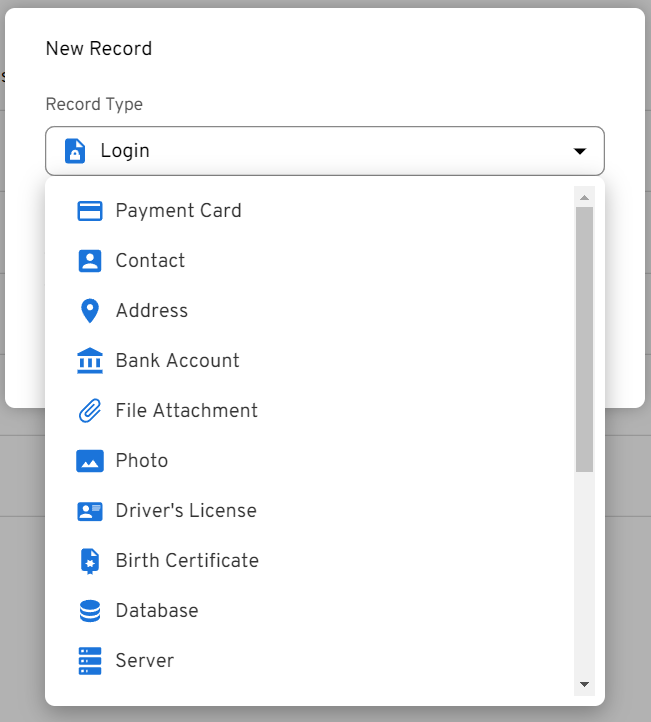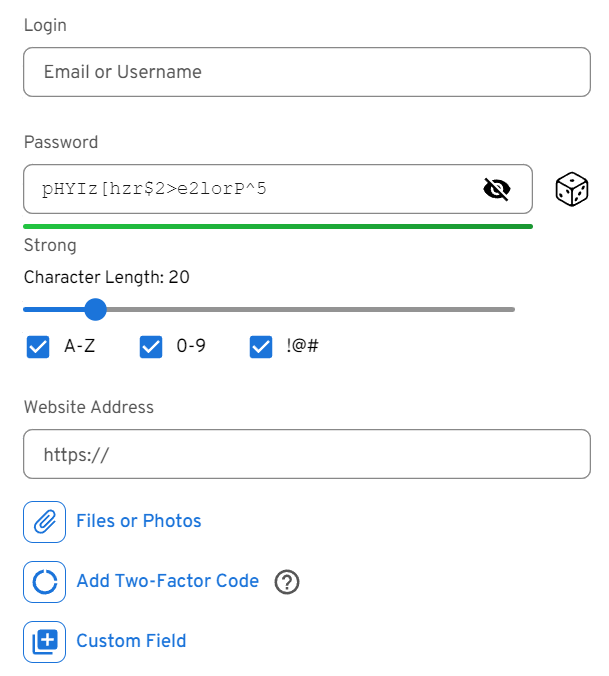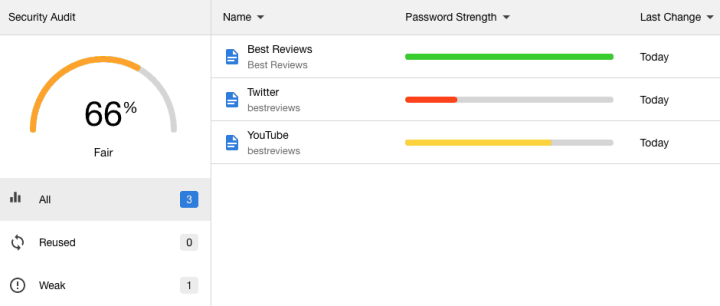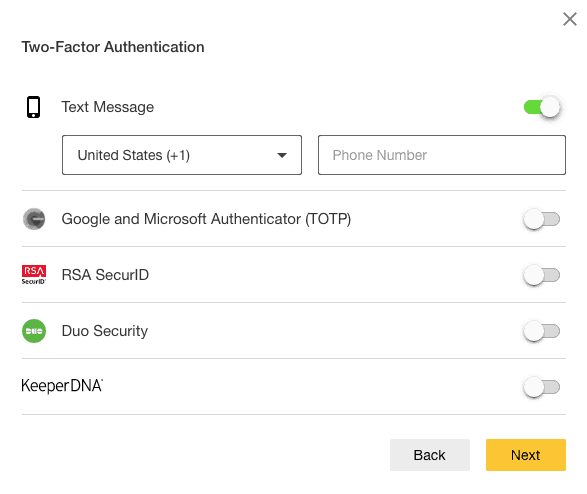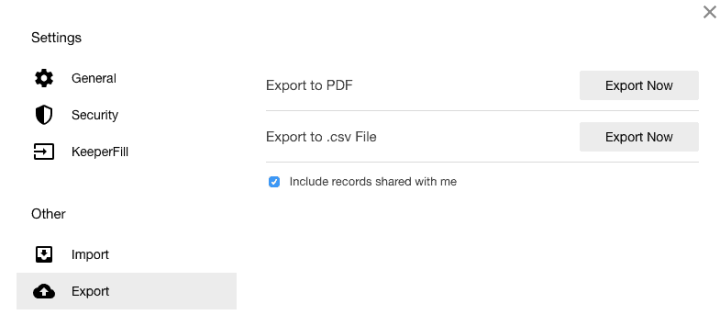Features
Keeper allows you to filter your password library by favorited, shared, or two-factor passwords. Unfortunately, you aren’t able to categorize them, but they can be sorted into somewhat cumbersome folders as an alternative. The password menu isn’t the prettiest but if you change to the icon view, you’ll see logos for a selection of popular websites making them easier to pick out.
Creating a password entry gives you a large number of options; besides your typical login details, you’re able to add the website address, files, photos, two-factor authentication, notes, and custom fields of your choosing. Bank card entries allow you to add all your usual details as well as your billing address but there’s no field for adding your pin number. Password generation starts at a low 16-character length but has a high maximum limit of 51 characters – it’s a good thing you don’t need to remember those passwords.
Autofill works with Keeper’s KeeperFill function that covers all the major web browsers as well as native macOS and Windows apps. One annoyance we had with this is that the shortcuts for the macOS’s KeeperFill are the same as existing default Mac functions, but these are at least changeable in the settings.
TRY KEEPER FOR FREE
Users have plenty of options with how they want to share data; you can allow different amounts of functionality for the intended recipient, so the password credentials are read-only, sharable, editable, or users are able to transfer ownership to another person altogether. New PasswordNew CardPassword GenerationSecurity Audit
New Password
Apps & Browser Extensions
Your Passwords will always be secure with Keeper! Try Keeper FreeKeeper has apps for all the major operating systems: Mac, Windows, iOS, Android, also including Kindle and Linux. As well as having KeeperFill automatically input passwords for you on native macOS and Windows apps, Keeper offers browser extensions for, Firefox, Edge, Internet Explorer, Opera, and Safari. Alternatively, you can use the web vault and never have to download any apps or extensions whatsoever.
Sharing over multiple platforms is easy; mobile apps have a sync button that will add any new passwords you’ve inputted through other apps – this is also available on the free version. Our only criticism of Keeper’s apps is that they aren’t the best-looking ones around. The vault, in particular, isn’t great to look at when compared to what’s on offer from other rivals and it is awkward to navigate.
Setup
For users new to password managers, Keeper provides a tutorial to get you started showing you how to input your passwords as well as exploring other features on offer. The most important thing you’ll do during that is set up a master password – it’s essential that you don’t forget this, as well as a security question that is required for account recovery. The tutorial then helps you input your bank card details, install browser extensions, and set up two-factor authentication.
Keeper allows you to import and export your files easily. Users can import from many of the major password companies or by using text files, and Keeper also detects existing saved passwords in its many supported browsers. Exporting your passwords gives you the choice of doing this as a text file or as a PDF, and reassuringly you’ll need to input your master password to export any passwords.Two-factor AuthenticationImport OptionsExport Options
Two-factor Authentication
Security & Privacy
Security is where Keeper really earns its stripes claiming to be ‘fanatical’ about protecting your information, which would explain why it has some of the best security we’ve seen on the password manager market. Keeper uses AES-256 and PBKDF2 encryption which is encrypted on your device and not in the cloud or on its servers.
Keeper offers two-factor authentication, which is always advisable, in the form of text messages, RSA SecurID, Duo Security, Google Authenticator, Microsoft Authenticator, and its own Keeper DNA. Keeper also supports U2F security keys as well as fingerprint authentication for compatible devices.
Users can set up a self-destruct sequence for Keeper which will erase all locally stored passwords in the event of five consecutive, unsuccessful login attempts – obviously, use this at your own risk. If anything happens to you, like an emergency (or something graver), then you then have the option of finding five trusted users that are able to gain access to your account over a period of time although they’ll still never know your master password.
BreachWatch

For ultimate security, users will have to invest a little more to install Keeper’s BreachWatch tool which monitors the murky waters of the dark web for any leaked password credentials. You can set BreachWatch to compare your passwords to the database of passwords circulating on the dark web and you’ll be informed as soon as any of your accounts are at risk. So, if you have an incredibly complex randomly generated 51-character password and it’s been found on the dark web, there’s a good chance that your account has been compromised and you’ll be able to quickly react. BreachWatch adds on an extra $19.99 but if you want added peace of mind then it’s well worth the price.
Pricing
There are various ways of purchasing the premium version of Keeper with deals for personal and family accounts as well as options for businesses. Personal accounts cover one person over multiple devices and come as low as $2.04 a month, billed every three years at $73.48. The best way to save money however is with the family account which covers five people at $157.48 with a 3-year subscription, meaning each member of the family could be paying just 87 cents a month for Keeper. Of course, the ultimate savings is to be made by restricting yourself to the free version only, but this limits the number of features and it only works on one device.
Since Keeper produces more than just password managers, users can save by getting bundles that come with Keeper’s encrypted private messenger service, secure file storage, and BreachWatch dark web monitoring. Although it will mean doubling the price of your subscription, it does come as excellent value to have everything included and BreachWatch in particular is well worth the money.
The premium version of Keeper comes with a 30-day free trial if you want to test everything out first but be warned that if you do decide to subscribe, Keeper doesn’t offer any money-back guarantee. Keeper Free$0Free Forever
More InfoKeeper Unlimited$2.04/month Billed Every 3 Years
- Unlimited password storage
- Unlimited devices
- Emergency access
- 1 private vault
- Password autofill
- Multi-device sync
- –
More InfoKeeper Family$4.37/mo Every 3 Years
- Unlimited password storage
- Unlimited devices
- Emergency access
- 5 private vaults
- Password autofill
- Multi-device sync
- 10GB file storage
More Info
Your Passwords will always be secure with Keeper! Try Keeper FreeCustomer Service
Keeper offers its users 24/7 support over live chat as well as email through the online form, with some fast response times. Although Keeper has a strong social media presence on Facebook and Twitter, it’s not the best place to get support.
We’re big fans of the vast amount of resources available on the Keeper website, which has a large number of user guides and video tutorials to help you get the most out of its software. There’s also a frequently updated blog with the latest about Keeper, and a large resource library full of information including webinars about internet security for you to watch.

